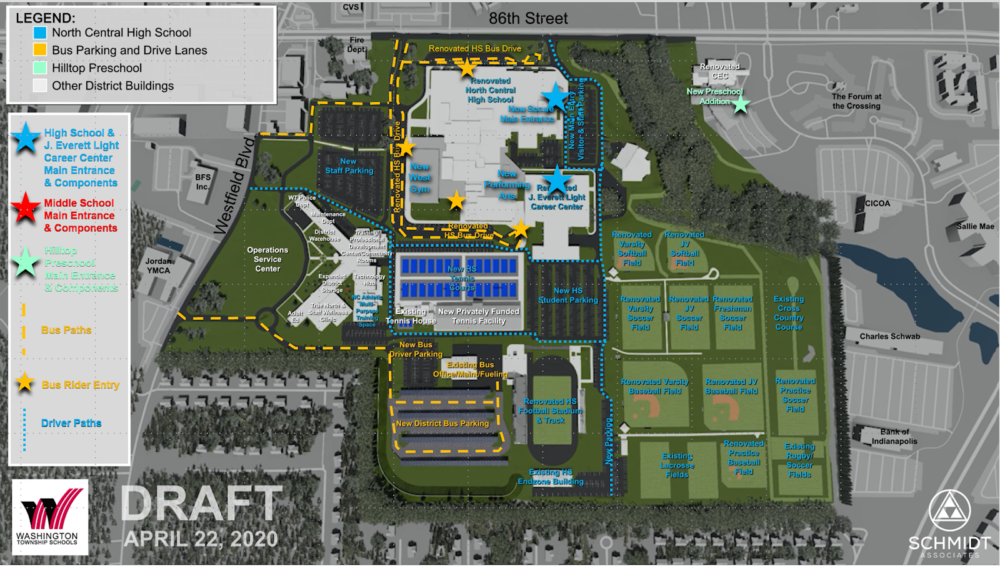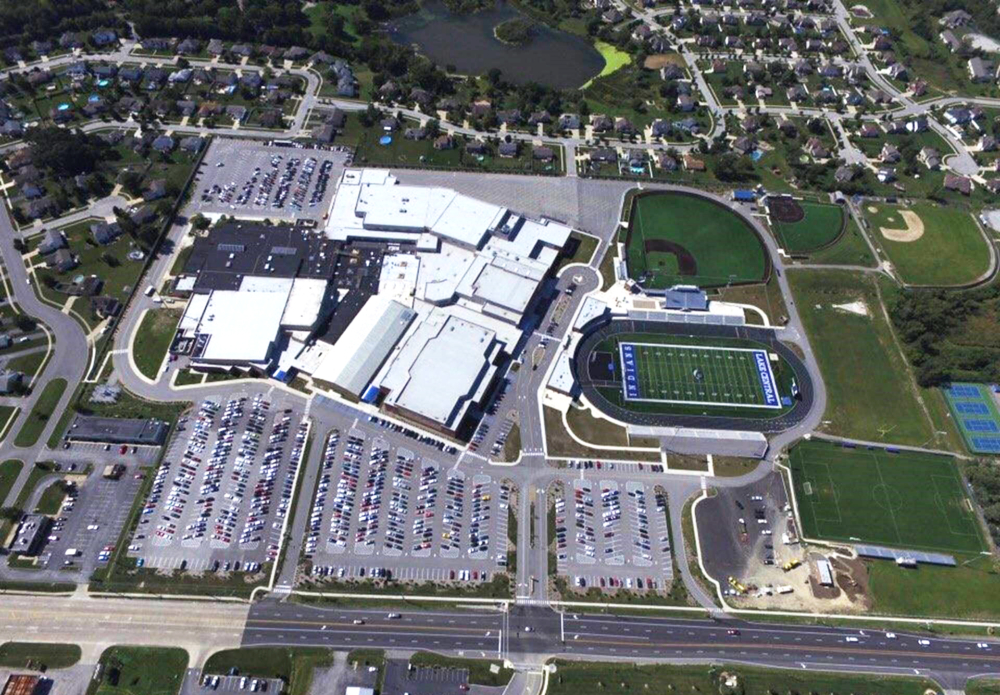Does Your K-12 School District Need a Master Plan?
-
Category
Studio-K12 -
Posted By
Anna Marie Burrell -
Posted On
Aug 12, 2020
The short answer to this question is, “Yes.” If your district doesn’t have one, or you have never been involved in a master planning process before, you likely have a lot of questions. Let’s start with the basics.
What is a master plan?
A master plan is a roadmap for the future of your school district, specifically in terms of physical space. It illustrates an ideal state of your district that supports your mission and goals. It also includes the steps, timeline, and associated costs for getting there. It outlines upgrades and renovations to existing school facilities, as well as potential new buildings, that will be necessary to accomplish your initiatives and accommodate anticipated changes within your district.

From MSD Washington Township’s Master Plan
Why does your school district need a master plan?
Creating and maintaining a master plan sets up your K-12 school district—and, ultimately, your students—for success. It aligns the district’s facilities with its future educational program, core values, and goals. It provides flexibility and options that will allow you to pivot to best serve your students and community for many years to come.
One important goal that a master plan can help many K-12 school districts achieve is greater equity for students across schools. A master plan helps you craft a unified vision throughout the district so that students have the same access and opportunities from one school to the next. This means bringing your lacking facilities up to par in terms of their physical condition, amount of space, and types of space.
Undergoing the master planning process also:
- Provides an overall understanding of existing facility conditions and creates a benchmark to highlight the specific inequities across the district
- Engages stakeholders and gathers input to encourage ownership in the overall end goal and plan
- Provides a tool for communicating and sharing the vision of the end goal
- Outlines a guide for setting timeline and budget goals
When should your school district develop a master plan?
A K-12 school district needs to create a new master plan approximately every eight to 10 years. Some districts do it more frequently, and certain states mandate how often school facilities must be evaluated and plans updated. This systematic review and planning ensures continued alignment with district core values and goals. A new master plan accounts for shifts in anticipated educational programs, student body demographics, and financial circumstances.
Begin a new master planning process as early as possible to give yourself ample time for communication, testing, and adjusting the vision as you go. Depending on the size of your district and how involved your community needs to be in the process, you could benefit from starting a year or more before your ideal plan completion date. If you rush the process, you risk having an incomplete plan or a lack of community ownership in the final vision.
What should you expect from the master planning process?
A successful K-12 master planning process is focused, thorough, and collaborative. It highlights the strengths of a school district and provides solutions for any weaknesses. The process must also involve key stakeholders—such as faculty and staff, parents, and boosters—to provide feedback and gain buy-in. The result is a feasible and actionable plan with the necessary support to see it through.
At a high level, the master planning process includes five basic components:
- Conditional Assessment – A conditional assessment evaluates the current state of every building, athletic field, and parking lot in your school district. This includes the effectiveness of the spaces, as well as the quality of their physical condition. Any problems will be documented, and facilities will be ranked based on the attention they need.
- Utilization Assessment – A utilization assessment looks at the types, quantities, and sizes of spaces that currently exist throughout the district. This information is used to develop an Educational Space Program. This program informs how existing spaces need to be altered and what new spaces may need to be added to appropriately accommodate current capacity, as well as achieve the district’s academic and extracurricular goals for the future.
- Design Exploration – All of this information is used to develop preliminary designs for the district’s facilities. This includes graphics to illustrate various site and building options.
- Cost Estimating and Phasing – Once the vision and preliminary design is determined, costs are estimated and assigned to each project. Projects are prioritized, and a timeline is developed for the estimated completion of each project.
- Engagement and Communication – Perhaps the most important step in this process is appropriately engaging your stakeholders and communicating the vision and plan. How you do this should be tailored to your district and community. It could include creating a blog site to share regular updates with the public, facilitating dialogue via a social media group, or hosting regular community input sessions—or a combination of a variety of tactics and mediums.
What happens after the master plan is created?
Once your plan is developed, you can begin to complete the projects on your list as you have prioritized them and as funding is available. However, it’s important to remember that a master plan is never “done.” Students’ needs change, circumstances change, and the world changes, which means your master plan will evolve with you. As you check off steps and complete projects, you will revisit your master plan regularly and make adjustments as needed to ensure it remains a relevant and useful tool.


Lake Central High School
[av_hr class=’short’ height=’-15′ shadow=’no-shadow’ position=’center’ custom_border=’av-border-thin’ custom_width=’50px’ custom_border_color=” custom_margin_top=’30px’ custom_margin_bottom=’30px’ icon_select=’yes’ custom_icon_color=” icon=’ue808′ font=’entypo-fontello’ av_uid=’av-kdfwe0yh’ custom_class=” admin_preview_bg=”]
[av_one_full first min_height=” vertical_alignment=” space=” custom_margin=” margin=’0px’ row_boxshadow=” row_boxshadow_color=” row_boxshadow_width=’10’ link=” linktarget=” link_hover=” padding=’0px’ highlight=” highlight_size=” border=” border_color=” radius=’0px’ column_boxshadow=” column_boxshadow_color=” column_boxshadow_width=’10’ background=’bg_color’ background_color=” background_gradient_color1=” background_gradient_color2=” background_gradient_direction=’vertical’ src=” background_position=’top left’ background_repeat=’no-repeat’ animation=” mobile_breaking=” mobile_display=” av_uid=’av-34e56k’]
[av_button label=’Want more helpful insights? Subscribe to our e-newsletter’ link=’manually,https://schmidt-arch.com/newsletter-sign-up/’ link_target=’_blank’ size=’large’ position=’center’ label_display=” icon_select=’no’ icon=’ue800′ font=’entypo-fontello’ color=’theme-color’ custom_bg=’#444444′ custom_font=’#ffffff’ av_uid=’av-kdfwcfrg’ custom_class=” admin_preview_bg=”]
[/av_one_full][av_hr class=’invisible’ height=’25’ shadow=’no-shadow’ position=’center’ custom_border=’av-border-thin’ custom_width=’50px’ custom_border_color=” custom_margin_top=’30px’ custom_margin_bottom=’30px’ icon_select=’yes’ custom_icon_color=” icon=’ue808′ font=’entypo-fontello’ av_uid=’av-kdfwe0yh’ custom_class=” admin_preview_bg=”]




